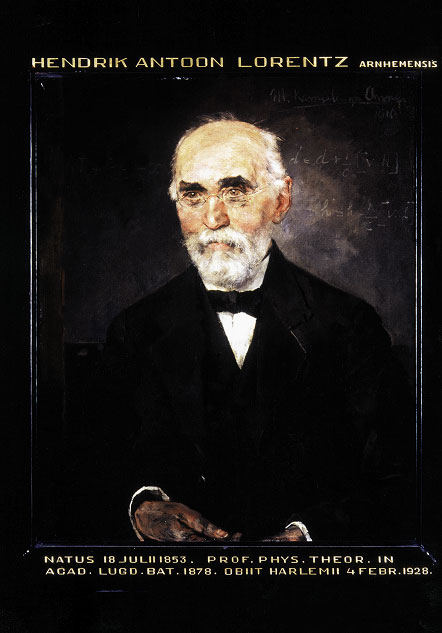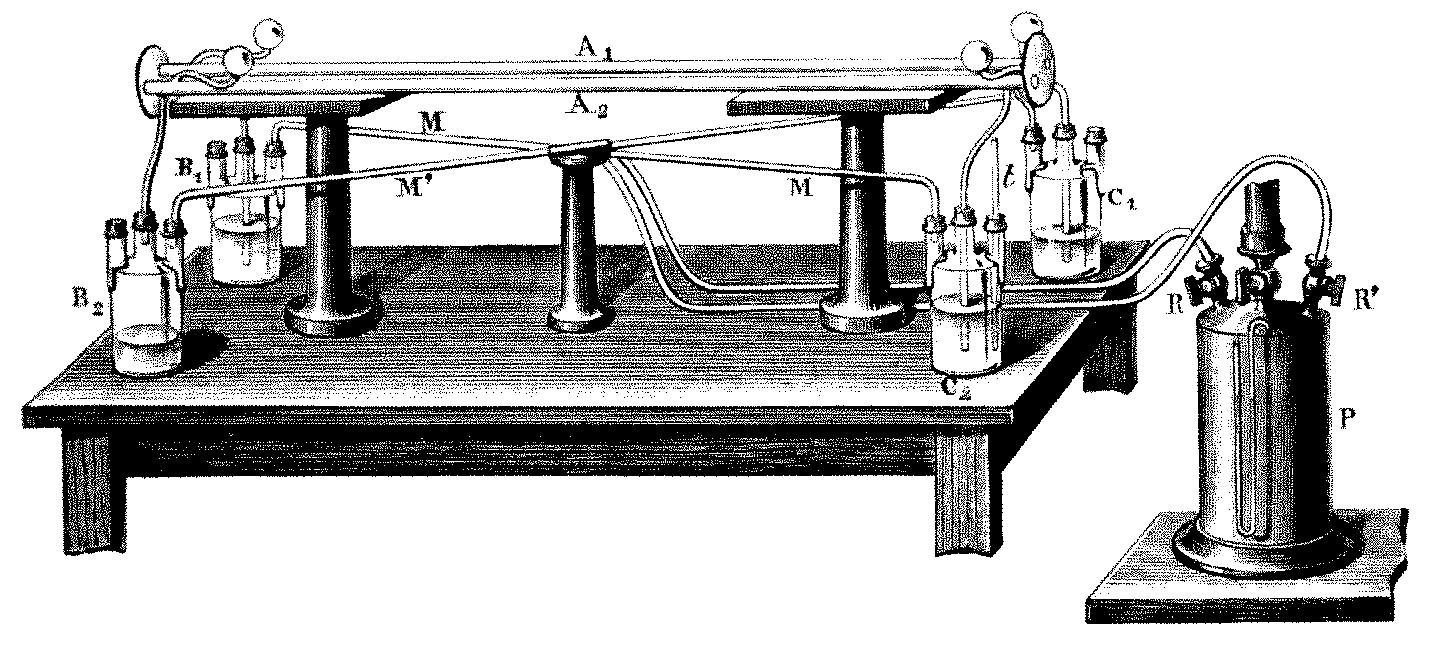|
Foucault's Measurements Of The Speed Of Light
In 1850, Léon Foucault used a rotating mirror to perform a differential measurement of the speed of light in water versus its speed in air. In 1862, he used a similar apparatus to measure the speed of light in the air. Background In 1834, Charles Wheatstone developed a method of using a rapidly rotating mirror to study transient phenomena, and applied this method to measure the velocity of electricity in a wire and the duration of an electric spark. He communicated to François Arago the idea that his method could be adapted to a study of the speed of light. The early-to-mid 1800s were a period of intense debate on the particle-versus-wave nature of light. Although the observation of the Arago spot in 1819 may have seemed to settle the matter definitively in favor of Fresnel's wave theory of light, various concerns continued to appear to be addressed more satisfactorily by Newton's corpuscular theory. Arago expanded upon Wheatstone's concept in an 1838 publication, suggest ... [...More Info...] [...Related Items...] OR: [Wikipedia] [Google] [Baidu] |
Léon Foucault
Jean Bernard Léon Foucault (, ; ; 18 September 1819 – 11 February 1868) was a French physicist best known for his demonstration of the Foucault pendulum, a device demonstrating the effect of Earth's rotation. He also made an early measurement of the speed of light, discovered eddy currents, and is credited with naming the gyroscope. Early years The son of a publisher, Foucault was born in Paris on 18 September 1819. After an education received chiefly at home, he studied medicine, which he abandoned in favour of physics due to a blood phobia. He first directed his attention to the improvement of Louis Daguerre's photographic processes. For three years he was experimental assistant to Alfred Donné (1801–1878) in his course of lectures on microscopic anatomy. With Hippolyte Fizeau he carried out a series of investigations on the intensity of the light of the sun, as compared with that of carbon in the arc lamp, and of lime in the flame of the oxyhydrogen blowpipe; on the int ... [...More Info...] [...Related Items...] OR: [Wikipedia] [Google] [Baidu] |
George Airy
Sir George Biddell Airy (; 27 July 18012 January 1892) was an English mathematician and astronomer, and the seventh Astronomer Royal from 1835 to 1881. His many achievements include work on planetary orbits, measuring the mean density of the Earth, a method of solution of two-dimensional problems in solid mechanics and, in his role as Astronomer Royal, establishing Greenwich as the location of the prime meridian. Biography Airy was born at Alnwick, one of a long line of Airys who traced their descent back to a family of the same name residing at Kentmere, in Westmorland, in the 14th century. The branch to which he belonged, having suffered in the English Civil War, moved to Lincolnshire and became farmers. Airy was educated first at elementary schools in Hereford, and afterwards at Colchester Royal Grammar School. An introverted child, Airy gained popularity with his schoolmates through his great skill in the construction of peashooters. From the age of 13, Airy stayed frequen ... [...More Info...] [...Related Items...] OR: [Wikipedia] [Google] [Baidu] |
Astronomical Unit
The astronomical unit (symbol: au, or or AU) is a unit of length, roughly the distance from Earth to the Sun and approximately equal to or 8.3 light-minutes. The actual distance from Earth to the Sun varies by about 3% as Earth orbits the Sun, from a maximum (aphelion) to a minimum (perihelion) and back again once each year. The astronomical unit was originally conceived as the average of Earth's aphelion and perihelion; however, since 2012 it has been defined as exactly (see below for several conversions). The astronomical unit is used primarily for measuring distances within the Solar System or around other stars. It is also a fundamental component in the definition of another unit of astronomical length, the parsec. History of symbol usage A variety of unit symbols and abbreviations have been in use for the astronomical unit. In a 1976 resolution, the International Astronomical Union (IAU) had used the symbol ''A'' to denote a length equal to the astronomical ... [...More Info...] [...Related Items...] OR: [Wikipedia] [Google] [Baidu] |
Speed Of Light Calculation Using Foucault's Rotating Mirror
In everyday use and in kinematics, the speed (commonly referred to as ''v'') of an object is the magnitude of the change of its position over time or the magnitude of the change of its position per unit of time; it is thus a scalar quantity. The average speed of an object in an interval of time is the distance travelled by the object divided by the duration of the interval; the instantaneous speed is the limit of the average speed as the duration of the time interval approaches zero. Speed is not the same as velocity. Speed has the dimensions of distance divided by time. The SI unit of speed is the metre per second (m/s), but the most common unit of speed in everyday usage is the kilometre per hour (km/h) or, in the US and the UK, miles per hour (mph). For air and marine travel, the knot is commonly used. The fastest possible speed at which energy or information can travel, according to special relativity, is the speed of light in a vacuum ''c'' = metres per second (approx ... [...More Info...] [...Related Items...] OR: [Wikipedia] [Google] [Baidu] |
Photoelectric Effect
The photoelectric effect is the emission of electrons when electromagnetic radiation, such as light, hits a material. Electrons emitted in this manner are called photoelectrons. The phenomenon is studied in condensed matter physics, and solid state and quantum chemistry to draw inferences about the properties of atoms, molecules and solids. The effect has found use in electronic devices specialized for light detection and precisely timed electron emission. The experimental results disagree with classical electromagnetism, which predicts that continuous light waves transfer energy to electrons, which would then be emitted when they accumulate enough energy. An alteration in the intensity of light would theoretically change the kinetic energy of the emitted electrons, with sufficiently dim light resulting in a delayed emission. The experimental results instead show that electrons are dislodged only when the light exceeds a certain frequency—regardless of the light's intensity or ... [...More Info...] [...Related Items...] OR: [Wikipedia] [Google] [Baidu] |
Albert Einstein
Albert Einstein ( ; ; 14 March 1879 – 18 April 1955) was a German-born theoretical physicist, widely acknowledged to be one of the greatest and most influential physicists of all time. Einstein is best known for developing the theory of relativity, but he also made important contributions to the development of the theory of quantum mechanics. Relativity and quantum mechanics are the two pillars of modern physics. His mass–energy equivalence formula , which arises from relativity theory, has been dubbed "the world's most famous equation". His work is also known for its influence on the philosophy of science. He received the 1921 Nobel Prize in Physics "for his services to theoretical physics, and especially for his discovery of the law of the photoelectric effect", a pivotal step in the development of quantum theory. His intellectual achievements and originality resulted in "Einstein" becoming synonymous with "genius". In 1905, a year sometimes described as his ' ... [...More Info...] [...Related Items...] OR: [Wikipedia] [Google] [Baidu] |
Special Theory Of Relativity
In physics, the special theory of relativity, or special relativity for short, is a scientific theory regarding the relationship between Spacetime, space and time. In Albert Einstein's original treatment, the theory is based on two Postulates of special relativity, postulates: # The laws of physics are Invariant (physics), invariant (that is, identical) in all Inertial frame of reference, inertial frames of reference (that is, Frame of reference, frames of reference with no acceleration). # The speed of light in vacuum is the same for all observers, regardless of the motion of the light source or the observer. Origins and significance Special relativity was originally proposed by Albert Einstein in a paper published on 26 September 1905 titled "Annus Mirabilis papers#Special relativity, On the Electrodynamics of Moving Bodies".Albert Einstein (1905)''Zur Elektrodynamik bewegter Körper'', ''Annalen der Physik'' 17: 891; English translatioOn the Electrodynamics of Moving Bodies ... [...More Info...] [...Related Items...] OR: [Wikipedia] [Google] [Baidu] |
Hendrik Lorentz
Hendrik Antoon Lorentz (; 18 July 1853 – 4 February 1928) was a Dutch physicist who shared the 1902 Nobel Prize in Physics with Pieter Zeeman for the discovery and theoretical explanation of the Zeeman effect. He also derived the Lorentz transformation underpinning Albert Einstein's special theory of relativity, as well as the Lorentz force, which describes the combined electric and magnetic forces acting on a charged particle in an electromagnetic field. Lorentz was also responsible for the Lorentz oscillator model, a classical model used to describe the anomalous dispersion observed in dielectric materials when the driving frequency of the electric field was near the resonant frequency, resulting in abnormal refractive indices. According to the biography published by the Nobel Foundation, "It may well be said that Lorentz was regarded by all theoretical physicists as the world's leading spirit, who completed what was left unfinished by his predecessors and prepared t ... [...More Info...] [...Related Items...] OR: [Wikipedia] [Google] [Baidu] |
Michelson–Morley Experiment
The Michelson–Morley experiment was an attempt to detect the existence of the luminiferous aether, a supposed medium permeating space that was thought to be the carrier of light waves. The experiment was performed between April and July 1887 by American physicists Albert A. Michelson and Edward W. Morley at what is now Case Western Reserve University in Cleveland, Ohio, and published in November of the same year. The experiment compared the speed of light in perpendicular directions in an attempt to detect the relative motion of matter through the stationary luminiferous aether ("aether wind"). The result was negative, in that Michelson and Morley found no significant difference between the speed of light in the direction of movement through the presumed aether, and the speed at right angles. This result is generally considered to be the first strong evidence against the then-prevalent aether theory, as well as initiating a line of research that eventually led to special r ... [...More Info...] [...Related Items...] OR: [Wikipedia] [Google] [Baidu] |
Fizeau Experiment
The Fizeau experiment was carried out by Hippolyte Fizeau in 1851 to measure the relative speeds of light in moving water. Fizeau used a special interferometer arrangement to measure the effect of movement of a medium upon the speed of light. According to the theories prevailing at the time, light traveling through a moving medium would be dragged along by the medium, so that the measured speed of the light would be a simple sum of its speed ''through'' the medium plus the speed ''of'' the medium. Fizeau indeed detected a dragging effect, but the magnitude of the effect that he observed was far lower than expected. When he repeated the experiment with air in place of water he observed no effect. His results seemingly supported the partial aether-drag hypothesis of Fresnel, a situation that was disconcerting to most physicists. Over half a century passed before a satisfactory explanation of Fizeau's unexpected measurement was developed with the advent of Albert Einstein's theory ... [...More Info...] [...Related Items...] OR: [Wikipedia] [Google] [Baidu] |



.jpg)



